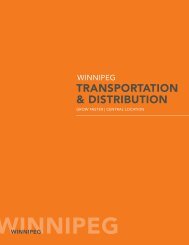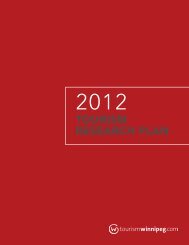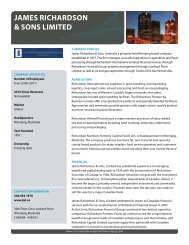Create successful ePaper yourself
Turn your PDF publications into a flip-book with our unique Google optimized e-Paper software.
<strong>Why</strong> <strong>Canada</strong> for Business1
<strong>Why</strong> <strong>Canada</strong> for Business1. Welcomes ForeignInvestment2. Top Performing Economy3. Open for Business4. … At Low Cost5. Educated Workforce6. Great Place to Live7. Stable Financial Sector8. Focused on Innovation9. Gateway to the World2
Rank$US1. Welcomes Foreign Investment• <strong>Canada</strong> ranks the best in the G-7 and 3rd overall in arecent study measuring a country’s ability to attractinvestment on the basis of economic infrastructure.1stEconomic Infrastructure for Attracting FDI - G-7 Ranking2nd3rd4th5th6th• Since the financial crisis and ensuing globaldownturn, <strong>Canada</strong> has outperformed major globaleconomies in attracting FDI: From 2008-2012,<strong>Canada</strong> was the largest recipient of per capitainflows among G-7 countries and the second largestin the G-20 following Australia.6,0005,000Cumulative FDI Inflows Per Capita in the G-7, 2008-2012$US5,8895,2997th4,0003,0003,3232,873<strong>Canada</strong> U.S. U.K. Germany Japan France ItalySource: Global Infrastructure Investment Index, EC Harris Consultancy, December 2012. * Standing among 40 countries.Economic infrastructure is the core internal facility of a country than makes business activity possible, such ascommunication, transportation, distribution, finance and energy supply. These assets are fundamental to society andeconomic growth.2,0001,00001,7441,026<strong>Canada</strong> U.K. U.S. France Germany Italy JapanSource: United Nations Conference on Trade Development (UNCTAD) Stat Database,November 20132773
%2. Top Performing Economy• <strong>Canada</strong> led all G-7 countries in economic growth over the past decade (2003-2012).• <strong>Canada</strong> has posted the fastest employment growth in the G-7 since July 2009.• <strong>Canada</strong>’s economy has recouped more than all of the output and jobs lost during the recession.• Almost 1,050,000 more Canadians are working today than when the recession ended.• <strong>Canada</strong>’s economy has produced high quality jobs with 9 in 10 positions created since July 2009 being in fulltimejobs and in high-wage industries.1514.4Number of Entrepreneurs as a Percentage ofthe Working Population2.52.01.8Real GDP Growth in G-7 Countries, 2003-2012(%)1.71012.311.911.5 11.4 11.49.89.3 9.31.51.01.41.2 1.21.10.90.550.00.0Source: Statistics Netherlands 2012.Source: World Bank, October 2013.All stats above aside from charts: Investment Strategy andAnalysis Division, Office of the Chief Economist, DFATD4
3. Open for Business• Forbes magazine ranked <strong>Canada</strong> as the Best Country for Business, the EUI estimates <strong>Canada</strong> will continue asthe leader for the Best Business Environment throughout 2014-2018.• <strong>Canada</strong> has the least amount of procedures for establishing a new business among G7 and OECD countries.The entire process to register a company in <strong>Canada</strong> is often done online and takes about five days.Time Required to Start a Business (days)Number of Procedures*252022109889151112157655 56 6 610556 674321100Source: Doing Business in 2014- The World Bank Group, 2013Source: Doing Business in 2014 - The World Bank Group, 2013 * A "procedure" is defined as any interactionof the company founder with external parties (government agencies, lawyers, auditors, notaries, etc).Interactions between company founders or company officers and employees are not considered as separateprocedures. For example, an inauguration meeting where shareholders elect the directors and secretary of thecompany is not considered a procedure, as there are no outside parties involved.5
3. Open for Business6
%4. … At Low Cost• Overall business costs in <strong>Canada</strong> are the second lowest in the G-7 and 5% lower than the U.S. 1• <strong>Canada</strong> is first in the G-20 to make itself a tariff-free zone for manufacturers by decreasing, since 2010, tariffs onmachinery, equipment and industrial inputs to reach zero by 2015. 2• In 2013, the federal statutory corporate income tax rate in <strong>Canada</strong> is 13 percentage points (or 33%) lower than that ofthe U.S. 36420-25.5Percentage Cost Advantage (Disadvantage)Relative to the United States5.03.92.10.0-0.145403530252023.0International Comparison of Statutory General CorporateTax Rates in 201339.137.034.430.227.526.1-415-6-8-10-9.4• <strong>Canada</strong> leads the G-7 in tax competitiveness. 1 710U.K. <strong>Canada</strong> Italy Germany France Japan U.S.* The tax rate on new business investment is the marginal effective tax rate (METR) that takes into account federal,provincial and territorial statutory corporate income tax rates, deductions and credits available in the corporate taxsystem and other taxes paid by corporations, including provincial capital taxes and retail sales taxes on business inputs.Source: Doing Business in 2014- The World Bank Group, 2013Source: Finance <strong>Canada</strong>, October 20131KPMG’s Competitive Alternatives Report.2Investment Strategy and Analysis Division, Office of the Chief Economist, DFATD3Finance <strong>Canada</strong>, October 2013
5. Educated Workforce• Five Canadian universities are ranked among the top 100 in the world. (UK-based Quacquarelli Symonds(QS) World University rankings for 2013)• <strong>Canada</strong> has the highest proportion of college and university graduates among OECDcountries – 51% of the adult population have post-secondary education.• <strong>Canada</strong> has a technology savvy population and workforce. It leads the G-7 with respect toInternet users per capita and is second to the U.S. among the G-7 in terms of personalcomputers per capita. (IMD, World CompetitivenessYearbook 2013)• Canadian schoolchildren ranked first in theG-7 and fifth among all 65 countries surveyedin the OECD Program for InternationalStudent Assessment (PISA).• <strong>Canada</strong> has one of the world’s most diversesocieties with over 200 languages identifiedas mother tongue. (Statistics <strong>Canada</strong>, 2011)8
IndexIndex5. Educated Workforce• <strong>Canada</strong> ranks second in the G-7 in availabilityof qualified engineers in its labour market.• <strong>Canada</strong> ranked first in the G-7 in a studymeasuring the extent to which managementeducation meets the needs of the businesscommunity (see chart below).Qualified Engineers Availability Index8.07.57.647.43Management Education Quality Index8.58.07.97 7.92 7.927.06.56.786.617.57.06.57.247.016.546.05.55.05.945.046.05.824.54.475.5France <strong>Canada</strong> Japan U.S. Italy U.K. Germany4.0<strong>Canada</strong> USA Germany U.K. France Italy JapanSource: IMD, * Rank among 60 economies considered in the World Competitiveness Yearbook 2013.Source: IMD, * Rank among 60 economies considered in the WorldCompetitiveness Yearbook 2013.9
RankIndex6. Great Place to Live• <strong>Canada</strong> has the highest standard of living in the G-7 and thesecond highest in the G-20 as measured by the Gross DomesticProduct (GDP) per Capita. (World Bank 2013)• <strong>Canada</strong> enjoys political and economic stability, and ranks firstand second, respectively, among the G7 for a fair justice systemand secure country. (Consider<strong>Canada</strong>.com)Democracy Index* G-7 Ranking• According to the Legatum Prosperity Index*, <strong>Canada</strong>ranks 1st in the G-7 and 3rd among 142 countries interms of overall prosperity based on material wealth andpersonal wellbeing.• <strong>Canada</strong> ranked first in the G-7 and third among the 36OECD countries in terms of overall living conditions andquality of life.8.5Better Life Index* G-7 Ranking1st2nd3rd4th5th6th7th8.07.57.06.57.877.647.497.076.716.186.05.865.5<strong>Canada</strong> Germany U.K. U.S. Japan France Italy5.0<strong>Canada</strong> U.S. U.K. Germany France Japan Italy*Index ranking countries based 60 indicators grouped in five different categories: electoral process and pluralism, civilliberties, functioning of government, political participation and political culture.Source: Economist Intelligence Unit, April 2013* Legal Prosperity Index ranks countries based on 89 variables grouped into 8 sub-indexes which areaveraged using equal weights. The sub-indexes are: economy; entrepreneurship & opportunity; governance;education; health; safety & freedom: personal freedom and social capital. Source: Legatum Institute, London,October 2013Better Life Index: Compendium of OECD Well-Being Indicators, OECD May 2013 * Indexbased on weighted average of 11 topics (housing, income, jobs, community, education,environment, civic engagement, health, life satisfaction, safety and work-life balance) identifiedas essential by the OECD in the areas of material living conditions and quality of life.10
Rank7. Stable Financial Sector• For the sixth consecutive year, the World Economic Forum (WEF) has declared <strong>Canada</strong>'s bankingsystem to be the soundest in the world.• During the financial crisis, no Canadian bank or insurer failed and none required bailouts.• Six of the top 10 safest banks in North America are Canadian, says Global Finance Magazine.• Standard & Poor’s has reaffirmed their AAA credit ratings for <strong>Canada</strong>.Soundness of Banks* World RankCapital Access Index (Maximum = 10)Top 10 Regions/Countries 20091st2nd3rd4th5th6th7th8th9th10th8.587.58.257.997.95 7.927.887.687.54 7.52 7.49 7.477<strong>Canada</strong>New ZealandSouth AfricaHong KongSingaporeFinlandPanamaNorwayAustraliaChile*Standing among 148 countries. Ranking based on the degree of soundness of financial institutions. Source: Global Competitiveness Report, 2013-2014** Standing among 500 world banks based on total assets and long-term credit ratings. Source: Global Finance Magazine, April 201311
8. Focused on Innovation• <strong>Canada</strong> offers one of the most generous R&D tax incentives in the industrialized world which can currently save firms, onaverage, 30 cents on a dollar invested in R&D in <strong>Canada</strong>.• R&D-intensive sectors in <strong>Canada</strong> also enjoy the lowest costs in the G-7, these being 10.7% lower than that in the U.S.• <strong>Canada</strong> is the lowest cost G-7 country in Digital and Research and Development operations.• <strong>Canada</strong> provides a system of tax credits and accelerated tax deductions for a wide-varietyof R&D expenditures. Eligible costs include salaries, overhead, capital equipment, andmaterials. Significantly reduced R&D costs for direct investment and sub-contracting.Relative Generosity ofR&D Tax Treatments*(Index: <strong>Canada</strong> = 100.0)Percentage Cost Advantage (Disadvantage) Relative to the USA…France123.9<strong>Canada</strong>100.0DigitalResearch & DevelopmentJapan85.9151050-5-10-1514.9<strong>Canada</strong>U.K.8.03.8FranceU.S.0.0-1.0GermanyItaly-4.3Japan-14.9151050-5-10-15-20-2510.7<strong>Canada</strong>9.1FranceU.K.5.2Germany0.4 0.0U.S.Italy-1.1Japan-24.9U.K.U.S.ItalyGermany80.677.076.184.050 60 70 80 90 100 110 120 130Source (Above chart and last stat): Warda, Jacek,Innovation: Measuring <strong>Canada</strong>'s R&D Tax Incentives:May 22, 2009. Data unchanged as of January 2012.Note: Relative generosity is determined by dividing theafter tax cost of performing $1.00 of R&D by 1 less thecorporate tax rate. Results are indexed to the relativegenerosity of <strong>Canada</strong>'s system of tax-based support forR&D. The higher the ratio the more competitive the taxsystem. Calculations based on large firmsSource (Charts and above data): KPMG Competitive Alternatives 201212
IndexMillions9. Gateway to the World• 17 of <strong>Canada</strong>’s 20 largest cities are located within a 90 minute drive of the <strong>Canada</strong>-U.S. border,anchoring trade valued at more than US$1.5 billion crossing the <strong>Canada</strong>-U.S. border each day.• <strong>Canada</strong>’s world class ports and airports are served by fast and reliable air, rail and road transport,provide international gateways to and from the North American continent.• Once CETA comes into force, foreign investors in <strong>Canada</strong> will have assured preferential access toboth NAFTA and the EU - a vibrant market of approximately 980 million consumers with acombined GDP of US$35 trillion, or nearly one-half of the world’s output of goods and services.5.45.25.0Enabling Trade Index - Standing Among G-7 Countries5.225.185.135.085.034.9025.020.0Annual Transborder CrossingsTotal Number of Trucks and <strong>Canada</strong>-U.S. Air Passengers(Two-way movements)4.815.04.64.44.24.0<strong>Canada</strong> U.K. Germany Japan France U.S. Italy4.3610.05.00.01983 1987 1991 1995 1999 2003 2007 2011*Global Enabling Trade Report 2012, WorldEconomic Forum.Source: Statistics <strong>Canada</strong> and Transport <strong>Canada</strong>, 2011 (* Preliminary data for 2011 .)13









